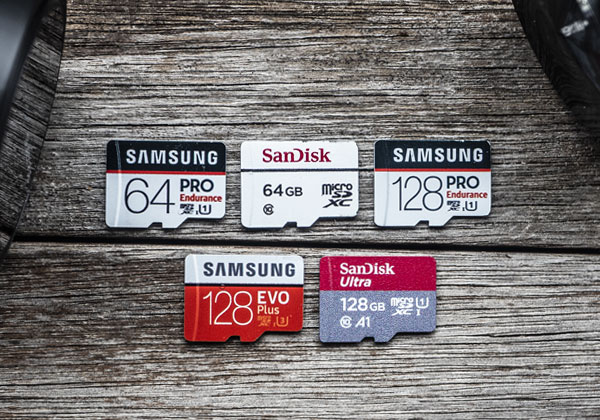
The best microSD cards keep your dash cam running. These endurance cards are more durable and prevent your video files from being corrupted.
Since its launch in 2018, 64GB Samsung Pro Endurance card has proven itself to be the top card for its value, reliability, and 3-year warranty.
Sandisk’s new 64GB High Endurance U3 card from 2019 is my runner-up choice. It costs less, but you have a lower 2-year warranty, a bit more issues with reliability, but overall this is a winning card.
Our Top Pick
64GB Samsung Pro Endurance
The Best MicroSD Card for Dash Cams
Incredibly durable for better recording reliability. It’s designed for use in dash cams, helping you keep your files safe. Backed by a 3-year warranty.
When dash cams overwrite older video files, that process permanently damages the memory card. The Pro Endurance is rated to last two times longer over our former top picks the Sandisk and Transcend High Endurance cards.
The Endurance has two years of proven reliability. We like the 64GB card over the 32GB option for its longer warranty (3 vs 2 years) and hours of 1080P videos recorded (26280 vs 12000 hours). We talk below on why endurance cards are better.
Runner Up
64GB Sandisk High Endurance U3
Cheaper Endurance Pick
Cheaper than Samsung with proven reliablity, it delivers everything you need in a microSD card but it has a lower endurance rating and a lower 2-year warranty.
Sandisk delivered a significant cost-savings and speed boost with its 2019 High Endurance refresh. It fixed compatibility issues with cameras not taking the older endurance card for being too slow.
Compared to Samsung’s card there are slightly more issues reported with counterfeit and failed cards, but minimal enough that it’s not significant. You also get 2-years, not 3 for warranty. If you need to save a few bucks or if the Samsung Pro Endurance is not available, this is a fine choice.
Budget Options
Samsung EVO Plus
Samsung EVO Select
Sandisk Ultra A1
Budget High Capacity Picks
Good options for professional drivers and parking mode users who need more space for cheap. No warranty or optimizations for dash cam use.
I would only get a non-endurance option to save money for large capacity cards. Otherwise the pricing is nearly the same as the 32 and 64GB Sandisk High Endurance.
These budget cards are made from 3D TLC NAND construction which has significantly decreased cost and failure rates and is a much better choice than cards from years past. Still, you should only get these cards if a $5 to $15 cost is important as you lose optimizations and a warranty compared to an endurance card.
The new Sandisk Ultra A1 cards have been completely redesigned and are good for dash cam use, older “Sandisk Ultra” versions must be avoided. We explain more further down.
Video Review
We talked about our recommended cards in a different, more visual way and covered some points we left out of the article.
Price Guide For Our Recommended Cards
Price changes will affect whether a card is worth buying especially in certain markets with limited availability for our recommended cards. As well our recommendations aren’t equal, a proven card with a warranty like the Samsung Pro Endurance is worth paying more money compared to the less proven Transcend or Kingston microSD cards.
Step 1: Eliminate Overpriced Cards
Find the prices of Samsung, Transcend, Kingston and Sandisk endurance cards. Remove any over the following amounts:
128GB: $45 USD – 64GB: $20 USD – 32GB: $13 USD
Note this is pricing for the United States – your country will be different
Step 2: Find the Best Value Card
Prioritize Samsung or Sandisk first, otherwise Kingston and Transcend Endurance can work. Avoid lesser-known endurance brands like Gigastone as non-endurance cards like the Samsung EVO+ or Sandisk A1 U3 would be better and proven reliable.
How We Picked Our Recommendations
All MicroSD Cards Have a Limited Lifespan
We started with a simple and important fact: Writing data (your video files) to a microSD card permanently damages its memory cells. When video files are overwritten, the memory cells are hit with electrical energy which degrades the semiconductor layer and increases data corruption. When too many cells are affected, the memory controller will lock the microSD card from writing new files. While this protects existing video footage, the SD card and therefore your dash camera will stop working.
Selecting The Right Memory Type
One of the most important but least known characteristics of microSD cards is the NAND type. The NAND type describes how the physical cells that store information were constructed.
SD vs microSD
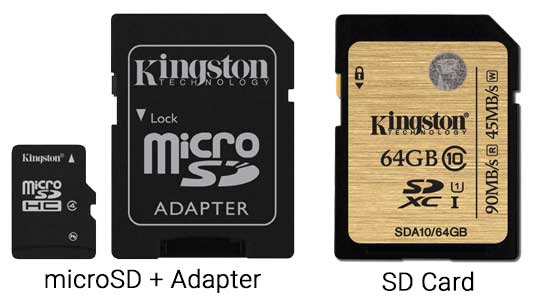 There are two physical sizes, SD and microSD. In 2019, all consumer dash cams we’ve seen use the smaller SD card size. There are only a few specialized cameras we’ve seen that use the larger SD card size. As well nearly all microSD cards include an SD card adapter so you’re covered for all uses.
There are two physical sizes, SD and microSD. In 2019, all consumer dash cams we’ve seen use the smaller SD card size. There are only a few specialized cameras we’ve seen that use the larger SD card size. As well nearly all microSD cards include an SD card adapter so you’re covered for all uses.3D NAND Reigns Supreme
Consumers used to see only two types of flash memory: TLC (Triple Level Cell) and MLC (Multi Level Cell). Both are planar (flat) which means all memory cells are on one layer.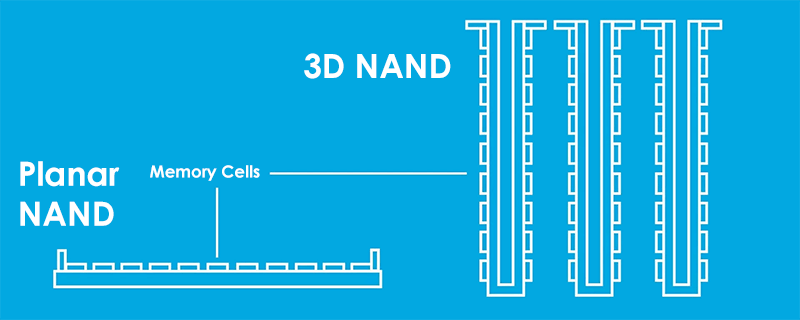
In 2020 the newest 3D NAND (layered) construction stacks memory cells on top of each other, now up to 176 layers. These layers can still be made from MLC, TLC or coming soon QLC (Quad-Level Cells).
There are two major benefits over our older picks which used planar MLC NAND: increased reliability (cells are larger which reduces interference) and cheaper prices (higher density on silicon wafers during manufacturing). If you’re interested in the technical details, read this whitepaper on 3D NAND (PDF).
This is why the current generation of Samsung EVO and Sandisk A1 have seen noticeably fewer reports of card failure compared to years past.
Faster SD Speeds Won’t Improve Performance
Almost all cards produced in 2019 are quick enough for even the most demanding dual channel dash cameras like the 4K Blackvue DR900S-2CH. There are some new standards like application and video class in addition to the older Speed Class and UHS Speed Class Ratings. They don’t matter too much except for the max read speed.
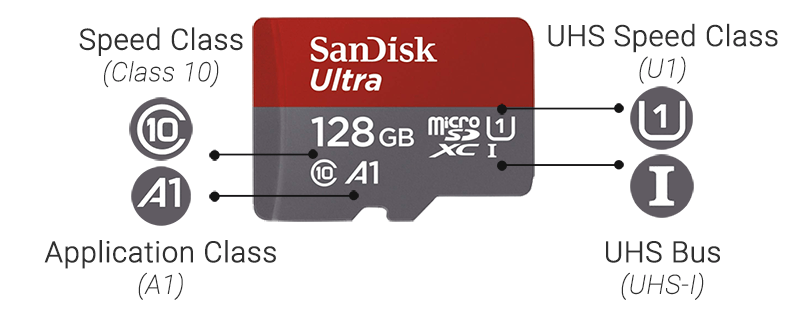
Speed Class

The oldest of ratings and measures the minimum write speed in megabytes per second. Class 10 is the fastest speed class rating.
UHS Speed Class
Stands for “Ultra High Speed” and refers to the minimum writing performance for recording video. Comes in U1 and U3 ratings for a write speed of 10 and 30 megabytes/second.
UHS Bus Speed
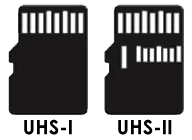
Extra pins on the UHS-II cards which increase transfer speed in supported devices (not dash cams).
Represents the transfer interface and uses the roman I or II symbols. A UHS-I rated card will generally have a higher max read speed over a “Speed Class” only card. EX: 20MB/s on SanDisk’s High Endurance versus 90MB/s in the Samsung Pro Endurance. UHS-II cards while faster isn’t supported by any dash camera and are very expensive.
Application Class
Comes in A1 or A2 rated SD cards. Targets smartphones and other computing devices that have different read/write operations from video devices. Seen in the SanDisk Ultra A1 and makes no difference in dash cam performance.
The 64GB Size is Worth Paying More
It’s only $7 more for the 64GB Pro Endurance. That’s a negligible amount for better peace of mind. In return, you get better durability, a longer warranty (Samsung Pro Endurance only) and extends recording time to at least 4 hours (helps to prevent accidental overwriting).
Professional drivers may want to use the larger 128GB+ cards to answer any complaints about their driving. These cards are more expensive per gigabyte and aren’t worth it for the average driver.
Why Endurance Cards Are Our Top Choice
If your microSD card fails your camera stops working. Cards like the Samsung Pro Endurance focus on better durability and reduced data corruption when writing video files to a card at 100% capacity. This helps ensure you capture and retain video footage for when you need it most. An endurance card will most likely last longer than general purpose cards like the Samsung EVO Plus but not always. See our section on “Mean Time Between Failure” on why.
Optimized Hardware & Firmware to Constantly Overwrite Files
Error-correction, wear-leveling and other write-heavy optimizations prevent the corruption of your videos files and improves lifespan. Most consumer cards focus on speed as they are used in smartphones and other devices that aren’t continually writing data. We see more issues with corrupted videos on budget cards, significantly fewer reports on Endurance models. Read this white paper (PDF) by Sandisk to learn more.
Rated for Years of Recording Time
Only endurance cards have a lifespan rating such as “17520 Hours of Recording at 26mbps” or “170 TBW (Terabytes Written)”. That’s over 5 years of recording time at 8 hours per day. This lifespan rating by the manufacturer makes us more confident in recommending these cards for dash cam use.
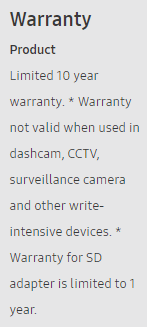
There’s a Warranty for Dash Cam Use
In the fine print for general use cards like the Samsung EVO Plus, many manufacturers void the warranty when used in surveillance devices like dash cams. Surveillance-focused cards have warranties that support their use in write-intensive applications. Two years was standard, but with Samsung’s confidence in 3D MLC NAND, they give 3 & 5 years for their 64 & 128GB cards respectively.
Faster MicroSD Speeds Won’t Improve Performance
While we researched card speed, the highest demanding dash cameras as of January 2019 will only use 1/3rd of the max transfer rate of UHS-1 and Class 10 cards. There is currently no need to pick a card which uses the faster U3, V30 or A2 speed limits as it doesn’t make the videos look better. We expect it’ll be a few years before we get 4K resolution on the front and back sensors and require a faster card.
Our Budget Picks Are Selected Using Community Reports
While it would be great if all our readers selected an endurance microSD card, larger 128GB+ endurance cards are significantly more expensive. We had to find a budget option with good reliability. Here’s how we made our recommendations:
Doing Endurance Testing on MicroSD Cards Is Difficult
Hearing a few reports on failed SD card isn’t enough. You need a larger test group to make the results relevant. One or two reports can be biased. A great example is the hard drive failure reports from BackBlaze to gauge the reliability of the 100,000+ hard drives in their servers. Ideally, we could buy hundreds of cards and overwrite them until they failed but we don’t have the resources (yet!) to make that happen.
Getting Large Sources of Data
Instead, we read posts from retailers and manufacturers who sell and bundle large quantities of microSD Cards. They’ll have data on the failure rate from customer feedback. BlackBoxMyCar sells Sandisk Ultra A1 cards and Street Guardian bundles Samsung EVO Plus & Select cards with their cameras. When you add reports on forums like DashCamTalk, it forms a good picture for us to recommend their cards.
Our Top Choice: 64GB Samsung Pro Endurance
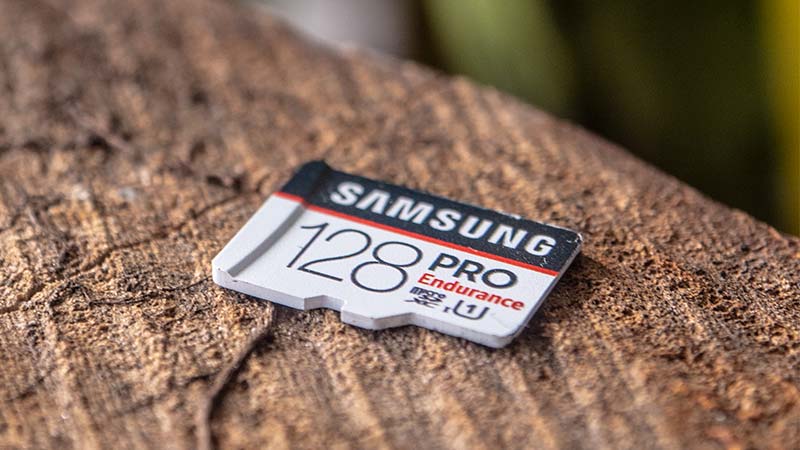
Our Top Pick
64GB Samsung Pro Endurance
The Best MicroSD Card for Dash Cams
Incredibly durable for better recording reliability. It’s designed for use in dash cams, helping you keep your files safe. Backed by a 3-year warranty.
Proven Reliability since 2018
You need data from thousands of users to prove reliability and since 2018 Samsung’s card has consistently excellent reports from users. There are very few reports of issues of this card failing and would be my top pick for anyone looking for a reliable card.
We read reports and tested the Pro Endurance with our premium picks (Thinkware F800 Pro, Blackvue DR900S-2CH, Street Guardian SG96663DC) as well as our budget models (Viofo A119 and Viofo A129 DUO). We’ve seen no problems so far which is also confirmed by numerous other dash cam owners over the years.
Max 128GB CardIf you need a larger card you’ll need to look at Sandisk’s High Endurance card which goes up to 128GB. Alternatively, for a Samsung-like warranty, the Sandisk Max Endurance with a 10-15 year warranty on their cards seem very promising.
Runner Up: 64GB Sandisk High Endurance
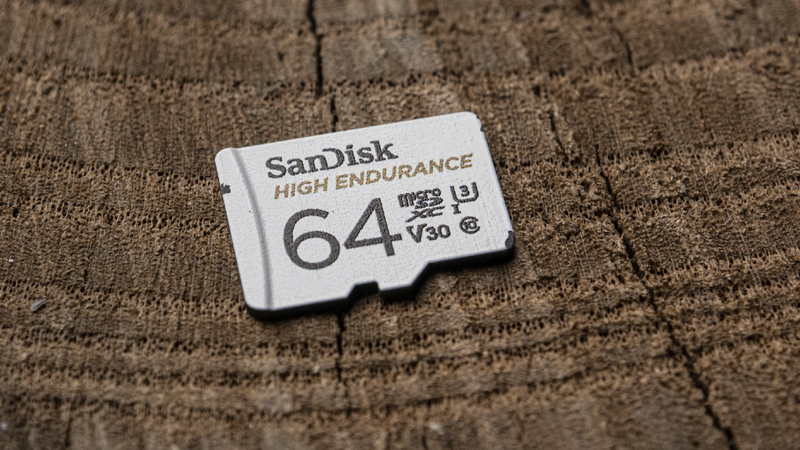
Runner Up
64GB Sandisk High Endurance U3
Cheaper Endurance Pick
Cheaper than Samsung, it delivers everything you need in a microSD card: 2-year warranty, proven reliability, and a 256GB option if you need lots of recording space.
Released in April 2019 the new Sandisk High Endurance cards have become the most popular endurance card on Amazon. They are highly rated and for good reason, it delivers some of the lowest-priced endurance cards on the market, with a good durability rating and warranty. If you need a 256GB endurance, this is the best value card to buy.
The specs look incredibly attractive against the Samsung Pro Endurance and against our budget non-endurance picks.
2019 Sandisk High Endurance Specs
256GB $44 | 20000 Hours | 2 Year Warranty | Max Read: 100MB/S
128GB $24 | 10000 Hours | 2 Year Warranty | Max Read: 100MB/S
64GB $14 | 5000 Hours | 2 Year Warranty | Max Read: 100MB/S
Comparison Cards
64GB Samsung Pro Endurance: $16 | 26280 Hours | 3 Year Warranty | Max Read: 90MB/S
128GB Samsung Pro Endurance: $28 | 43800 Hours | 5 Year Warranty | Max Read: 90MB/S
64GB Old Sandisk High Endurance: $17 | 10000 Hours | 2 Year Warranty | Max Read: 20MB/S
128GB Samsung EVO Select: $20 | No Warranty | Max Read: 100MB/S
256GB Samsung EVO Select: $30 | No Warranty | Max Read: 100MB/S
Budget High-Capacity Recommendations
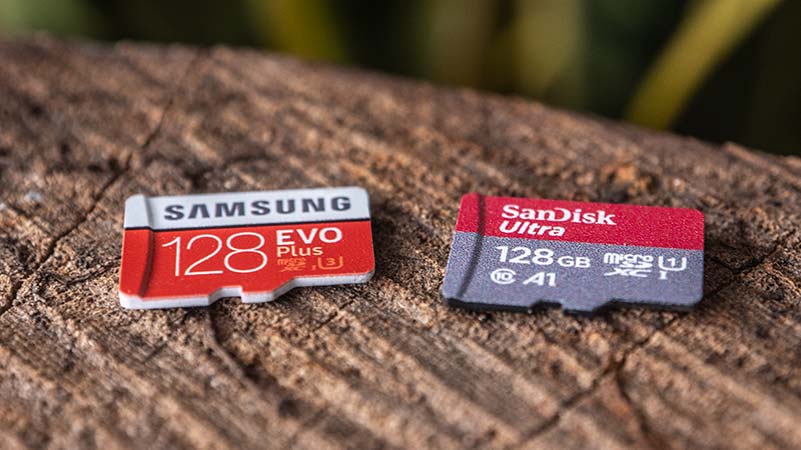
Budget Options
Samsung EVO Plus
Samsung EVO Select
Sandisk Ultra A1
Budget High Capacity Picks
Good options for professional drivers and parking mode users who need more space for cheap. No warranty or optimizations for dash cam use.
If you need a 128GB or 256GB and absolutely need to save money, these are the cards to get. While they don’t have optimizations for dash cam use or a warranty, these three cards have been extensively used and verified as reliable by the dash cam community.
As well, manufacturers like Street Guardian include the EVO Plus and large retailers like BlackBoxMyCar have been using the Sandisk A1 with great success.
When to Spend More on Endurance CardsIf saving $5 to $15 doesn’t matter for a 128GB or 256GB card, you should strongly consider our endurance picks instead. They’ll be more reliable and should they fail you can bring them to the manufacturer for a warranty swap. Otherwise, you void the warranty for non-endurance Samsung and Sandisk cards when used in dash cams or surveillance equipment
Samsung EVO Plus & EVO Select Are the Same CardsThe Select is an Amazon exclusive card that comes with a different external design from the EVO+. Internally, the hardware is the same.
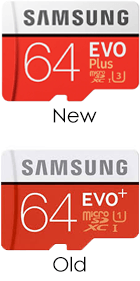 There’s An Older Samsung EVO+ Card
There’s An Older Samsung EVO+ CardThe EVO+ with the plus symbol was released in 2015 and rated at the U1 speed class. The newer Samsung EVO Plus (symbol typed out) was released 2017 and updated with U3 speeds. The older version is still being sold today – watch what you purchase.
Fewer Reported Card FailuresCompared to our previous budget recommendations (Transcend 400X, Lexar 633X) it’s a significant improvement in reported failures. We wouldn’t be surprised if these are made from 3D NAND (128GB Evo Plus is 3D NAND) but have not been able to confirm.
Larger 128GB+ CardsWe tested the 128GB EVO Plus and found it to work well in all our recommended dash cameras from budget to premium models that supports 128GB cards. The larger 256, 400 and 512GB cards have not been tested by us although the manufacturer Street Guardian has tested the 400GB Sandisk card and found it to work with their cameras.
Sandisk Ultra A1 Cards Are OK
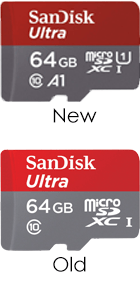
Back in 2016 we told our readers to avoid Sandisk Ultra cards due to their high failure rate. It was suspected the memory controller was especially aggressive with write locking the card when it detected errors. The new A1-Rated Ultra Cards have a new controller and a good track record so far. Notable retailers like BlackBoxMyCar have had success using them.
Why Bad Cards Can Still Last a Long Time
We often get messages from users with bad cards like the older Sandisk Ultra series (from 2016) who say their cards have been working for a long time and question the need for an endurance card. Almost to say “it doesn’t matter what card you buy”. Those people would be wrong.
Mean Time Between Failure (MTBF)
When a card is given an endurance rating (ex 26000 hours), that doesn’t mean it’s guaranteed to last at least that amount. The right concept is “Mean Time Between Failures” or MTBF. For us, this represents the average time a certain card will last before failing. With averages, some cards fail early and some last a long time before failing. Backblaze wrote an excellent article on MTBF talking about how long hard drives last.
What Does MTBF Mean for MicroSD CardsYou can have a Samsung Pro Endurance card that fails within a month or an older Sandisk Ultra card that lasts years without having a problem. Still, over thousands of cards, the Ultra cards will fail way earlier than the Pro Endurance models. We make our recommendations based on hundreds of reports, not a couple people saying it works or has problems.
The Competition
Sandisk Max Endurance
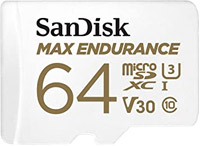
A very promising new card with the best warranty and endurance rating of any consumer card I’ve seen. Their 128GB and 256GB cards have a 10 and 15 warranty. My thoughts – not worth the money.
Samsung’s 5-year warranty is more than enough and few people will use the MAX for 10 years and claim the warranty. Save the money and get cheaper cards instead. There’s also no information on their reliability and compatibility as there’s only 300 reviews versus the 6000+ reviews on our endurance picks.
Sandisk High Endurance
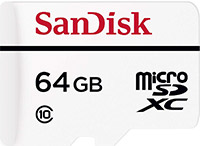
It had a good run but there’s no reason to purchase this slower, older card that’s more expensive. Get the Sandisk High Endurance U3 instead.
Kingston High Endurance
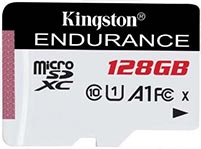
Kingston has launched their version of a high-endurance card on April 1st. We aren’t very interested as the price is similar to Samsung’s Pro Endurance but it lacks their warranty and hourly (but we don’t know the bitrate it was tested at so the endurance may be higher).
Transcend High Endurance

Transcend’s card used to be our favourite pick but their price has gone up and it’s hard to find in stock. While Transcend has a 20% higher durability rating and faster read speed, there’s no reason to recommend this card over Sandisk unless there’s a sale.
Transcend 400X

This is another card that used to be our budget pick. The Transcend 400X can still be found today at a cheap price but no longer recommended as our current Samsung and Sandisk selections have been more reliable than older tech cards.
Cards From Dash Cam Manufacturers
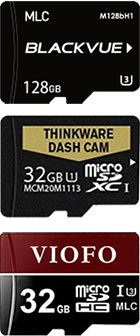
Companies like Blackvue, Thinkware and Viofo have their own branded cards. They’ll often say its best for compatibility but in 2020 we haven’t found a problem with using our picks. We looked at user reports and tested all our chosen cards with our premium camera picks (see our YouTube review) and found no issues. These cards are outdated and cost 2-3X more than a comparable Samsung card.
Western Digital WD Purple
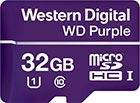
Released in April 2018 the WD Purple series is Western Digital’s attempt to enter the surveillance storage market. Unfortunately, their cards are more expensive and have much less endurance compared to Sandisk’s High Endurance card. Ex: 64GB WD Purple is $32 with 5470 Hours of 26MBPS recording while the 64GB Sandisk High Endurance is $17 with 10000 hours.
Lexar Everything

The 633X series was a good budget pick but after ownership changes, we cannot recommend their products at this time. In June 2017 the parent company Micron exited the consumer business and looked to sell Lexar. The brand was purchased by the Chinese company Longsys in Aug 2017. While they have started up production in Aug 2018 we don’t have enough data to determine quality at this time.
This ___ Card is On Sale
We often get asked whether certain non-endurance cards are good for dash cams. We honestly can’t say even though they are made from 3D NAND or MLC NAND. While they’ll likely work, without any statistics on failure rates in dash cams it’s impossible to say how well each card will do.
Prices Should Fall in 2020
Supply Issues in 2016-17 Increased Prices
Several years ago prices were nearly double as manufacturers switched to building 3D NAND factories causing a shortage of memory driving up prices. Generally, there’s a 2-year shortage followed by a 2-year oversupply period.
Oversupply in 2018 & 2019
In 2018 numerous 3D NAND factories became operational which has caused a glut in supply and dropping prices. As well a new major Chinese manufacturer – Yangtze Memory – may lead to a 3-year oversupply period. For dash cam owners, this is a great time to update an older memory card.
Unexpected Oversupply in 2020
2020 was expected to have rising NAND prices based on previous patterns. Cue Coronavirus – which caused mobile phones and server sales to fall. In general, expect prices to continue falling but for the average consumer, that’s a few dollars.
Get a Backup Card
We recommend you purchase a smaller 8-16GB card in case you get into an accident. You’ll be able to swap your cards out and keep recording without worrying that you’ll overwrite important footage. As well you’ll be protected in case your current card has any problems.
Counterfeit SD Cards & How to Avoid Them
Counterfeit SD cards are common if you don’t buy from reputable retailers. There’s an extensive guide that shows the counterfeiters’ sophistication and ability to trick you into purchasing a fake SD card.
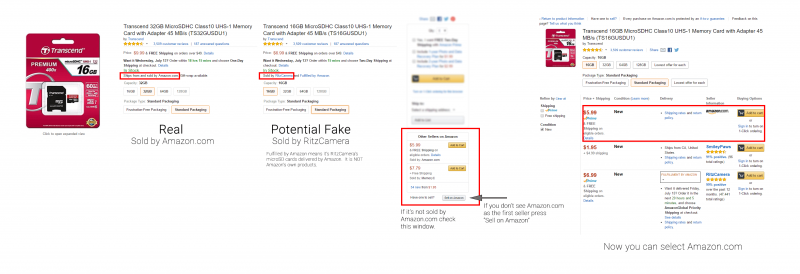
For your protection avoid all Chinese based storefronts like Aliexpress. You should also avoid eBay. If you buy from Amazon, check that it’s sold directly by Amazon. If it’s “fulfilled by Amazon” that is sold by a third party, some are legitimate and others will sell you fake cards.

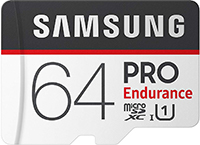
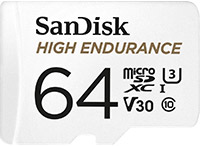
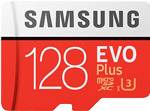
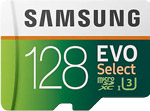
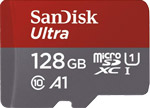
Hi Andrew,
thank you and I really enjoyed reading your article re: mSD cards. BTW, you are currently focusing & comparing on “Endurance” and MTBF life of the mSD cards, how about other environmental performance ratings (i.e. temperature, vibration, shock etc.) on the mSD cards used in the dash cams installed in various types of vehicles such as trucks and buses? How about on-board memories such as eMMC, SSD etc. which I’ve seen some dash cams has it in the newer dash cam models? Thanks, BK
One thing I don’t see mentioned is that when you buy a double size card the cells only get written to us half the time of a smaller card. You will cycle through a smaller card twice as fast and wear the cells out quicker than a larger card. For example, a 128 GB card might get over written every 8 hours, while the same amount of recording with a 64 GB card would be overwritten every four hours. Writes wear a card out, not the reads. Based on this, you will get double the life just because of the size of the card.
I’d be curious to hear other’s thoughts on this. Seems like a significant influencing factor on where to find the best balance between recording capacity and longevity.
Based on this premise, you might be able to buy a 512GB card (not endurance, because they don’t make them that big), but that might not matter since you would be wearing out the cells with writes at a reduced rate factor of 4X. You would write to the same cell on a 64GB card four times compared with only one time on the 512GB card.
Any thoughts on this from others in the know?
Thanks for the great write up by the way!
Is there a software utility that will allow you test whether a card is real? I live in Thailand where we dont have the same consumer protections that exist in the US. The same product can sell through “reputable” dealers for up to 100% difference in price, managers of reputable stores can sneak in fakes and online is basically a jungle. If you look on Lazada the local equivilant of Amazon its clear many are fakes but also much price gouging occurs.
Don’t bother with the Evo plus, I have one that’s failed after 2 months
128GB Samsung Pro Endurance has 5 year warranty, instead of 3. You might want to fix that.
Will arrive soon the SanDisk 256gb endurance. I will let you a feedback if interested here. Thanks for this great article @Andrew Lam.